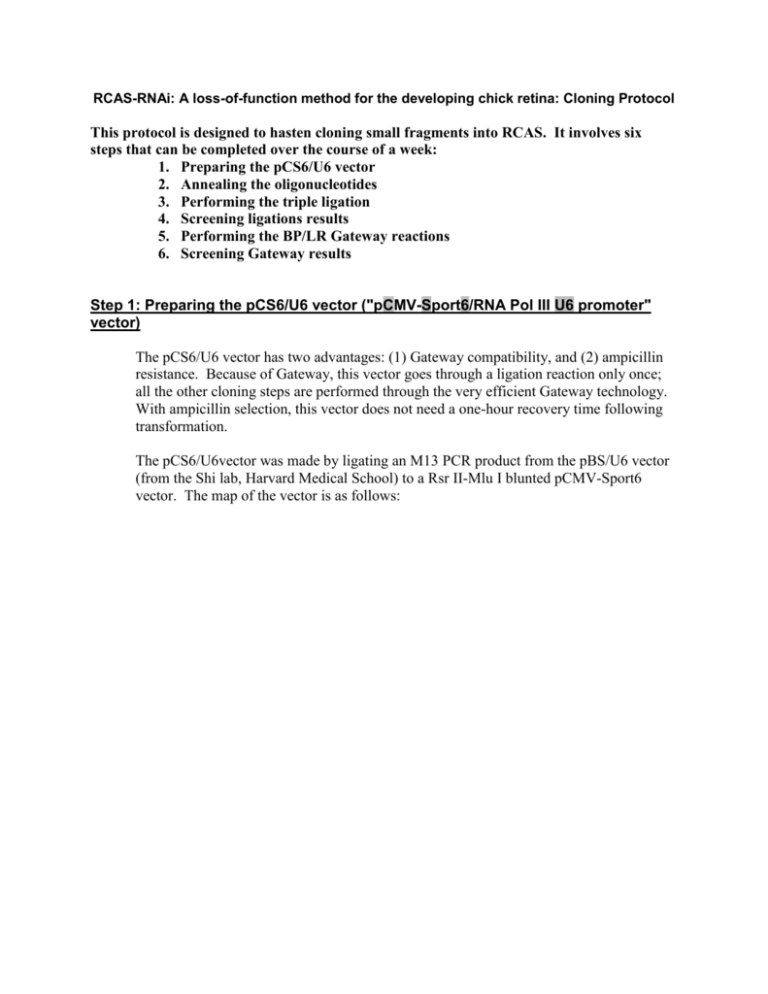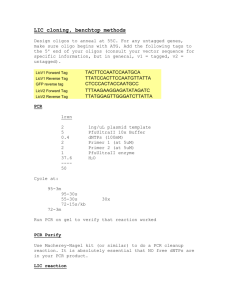file - BioMed Central
advertisement

RCAS-RNAi: A loss-of-function method for the developing chick retina: Cloning Protocol This protocol is designed to hasten cloning small fragments into RCAS. It involves six steps that can be completed over the course of a week: 1. Preparing the pCS6/U6 vector 2. Annealing the oligonucleotides 3. Performing the triple ligation 4. Screening ligations results 5. Performing the BP/LR Gateway reactions 6. Screening Gateway results Step 1: Preparing the pCS6/U6 vector ("pCMV-Sport6/RNA Pol III U6 promoter" vector) The pCS6/U6 vector has two advantages: (1) Gateway compatibility, and (2) ampicillin resistance. Because of Gateway, this vector goes through a ligation reaction only once; all the other cloning steps are performed through the very efficient Gateway technology. With ampicillin selection, this vector does not need a one-hour recovery time following transformation. The pCS6/U6vector was made by ligating an M13 PCR product from the pBS/U6 vector (from the Shi lab, Harvard Medical School) to a Rsr II-Mlu I blunted pCMV-Sport6 vector. The map of the vector is as follows: To prepare the vector, first perform an Apa I digest, then a T4 polymerase fill in, then an EcoRI digest, and then a CIP reaction: 1. ApaI digest 2. T4 Polymerase Fill In 20 ul miniprep 10 ul NEB#4 10 ul BSA 1mg/ml 5 ul Apa I 55 ul water 100 37.5 ul PCR purified product 10 ul 5X T4 Polymerase buffer 2 ul T4 Polymerase 1 ul 10mM dNTP 50 Let reaction run ~2 hr RT, Then purify using PCR purification kit and elute in 40 ul water Let reaction run 30 minutes, 37 degrees Then purify using PCR purification kit and elute in 88 ul water 3. EcoRI digest 4. CIP reaction 85 ul PCR purified product 10 ul Buffer H 5 ul EcoRI 30 ul PCR-purified product 3.5 ul CIP 10X buffer 1.5 ul CIP 100 35 ul Let reaction run ~2hr, 37 degrees Then purify using PCR purification kit and elute in 30 ul water Let reaction run 30 minutes, 37 degrees Then gel purify product (expect ~4600 bp piece and small piece – cut ~4600 bp piece) (Vector is CIP'd in this case is to minimize self-ligation without insert) Step 2: Annealing the oligonucleotides First, pick the appropriate gene sequences that will comprise the hairpin. A common strategy with the U6 promoter system is to look for sequences starting with 3 guanine nucleoides in sequence. Various other rules have been suggested in order to pick sequences that make the best hairpins, with a higher GC count (above 45%) thought to be better. However, for the chick retina no reproducible rule for picking effective hairpins has been found. It is recommended making multiple hairpins using sequences from different parts of the targeted gene and testing the constructs empirically. This technique requires ordering 4 oligonucleotides for a given 21 nucleotide sequence that fit together as follows: Once the sequences have been chosen, they have to be annealed. This requires phosphorylating them so that they can ligate together in the triple ligation. It also involves purifying the oligonucleotides. Unfortunately, the oligonucleotides are too small to be retrieved with the PCR purification columns, so a phenol/chloroform step is needed. The fastest way to do all of this is through technique adapted from Takahiko Matsuda, Cepko Lab, Harvard Medical School (perform same reaction for oligo 3 and oligo 4): 1. Annealing 5 ul 10X buffer H 6 ul 100uM oligo 1 6 ul 100uM oligo 2 33 ul water 50 ul Boil 800ml water in 1L beaker, place tubes in beaker for 1 minute, and then remove beaker (with tubes inside) from heat plate and let cool on bench for 30 minutes 3. Purification Add 90 ul water/PNK reaction Add 100 ul Phenol/chloroform Vortex quickly Spin at maximum speed 3 minutes Recover upper phase 2. Phosphorylate Annealed Oligos 2 ul Annealed Oligo 1 ul 10x PNK buffer 1 ul 10mM ATP 1 ul PNK 5 ul water 10 ul Let reaction run 30 minutes, 37 degrees 4. Precipitation 100 ul upper phase 300 ul 100% Ethanol 10 ul 3M NaOAc 1 ul Glycogen Carrier Spin 13K, 5 minutes Remove supernatent Add 500 ul 70% EtOH Spin 13K, 2 minutes Resuspend in 100 ul water Step 3: Performing the triple ligation Because the Takara I ligation reagent (http://takaramirusbio.com) is very efficient, it is preferred for the ligation steps: Experimental ligation: Control ligation: 1 ul vector 1 ul oligo A 1 ul oligo B 3 ul Takara I reagent 6 ul 1ul vector 2 ul water 3 ul Takara I reagent 6 ul This ligation can be performed at 16 degrees overnight, or it can be accomplished at room temperature for 30 minutes. Following the ligation, the DNA can be transformed by adding 6 ul ligation mix to 50 ul DH5a cells, heat shocking for 1.5 minutes at 42 degrees, recovering on ice for 2 minutes, adding 56 ul LB broth, and plating the entire 112 ul on AMP plates (recovery for 1 hour is not needed). Expect to see some colonies on the control plates, but many more on the vector+oligo plates. Step 4: Screening ligation results Many colonies that grow should be correct, but some may contain multiple inserts or the wrong sequence. To test these possibilities, there are many options including colony PCR, Bam HI digestion, and sequencing. Colony PCR is nice because it saves time (no need for cultures to grow overnight) and money (no need to do extra minipreps). Pick individual colonies, suspend each in 30 ul 1XPCR buffer, and perform PCR as follows: PCR mix/rxn: 1 ul 10XPCR buffer 1 ul 10uM T7 long primer 1 ul 10uM T3 primer 0.5 ul 10mM dNTPs 0.2 ul Taq 5.3 ul water 10 ul bug in 1XPCR buffer 20 ul PCR program: 1. 92 degrees, 1 minute 2. 92 degrees, 30 seconds 3. 58 degrees, 30 seconds 4. 72 degrees, 1 minute 5. Go to 2, 30X 6. 72 degrees, 5 minutes 7. 4 degrees, infinity As a control, use the pCS6/U6 vector DNA. The colonies with the correct inserts should produce a fragment indistinguishable from the pCS6/U6 vector product (remember: the uncut vector has sequence between the Apa I and EcoRI sites, which are approximately the same length as the inserted hairpin). 1.5-2% gels work best for this analysis, using marker VIII or V. For those colonies with the correct size, proceed with overnight cultures and minipreps. For overnight cultures, add 5 ul of colony in 1XPCR buffer to 3.5 ml LB broth + ampicillin and shake at 37 degrees. Digesting with Bam HI is another way to test the colonies, although it first requires miniprepping. One approach is the following: BamHI digest: 2 ul miniprep DNA 3 ul 10X Buffer B 2 ul BamHI 23 ul water 30 ul Again, for a control use pCS6/U6 vector. The correct inserts produce an ~400bp fragment indistinguishable from the control digest product. Finally, sequencing is an ideal way to confirm your product. However, many sequencing protocols cannot efficiently sequence through hairpins. One option is to first cut with HindIII and then send the sample for SP6 and T3 sequencing. Step 5: Performing the BP/LR Gateway reactions The Gateway reactions are really straightforward, and are best explained in the Gateway catalog at the Invitrogen website (www.invitrogen.com). Consult this manual to learn how to deal with the temperature sensitive clonase enzymes. The strategy involves cutting the pCS6/U6+insert vector with enzymes in the backbone to ensure that the vector will never re-ligate on itself. Then the vector is run through the BP and LR Gateway reactions (the reason why the vector goes through both reactions in this protocol is to completely avoid relying on the more tedious kanomycin resistance selection). 1. NcoI/ScaI vector backbone digest: 10 ul pCS6/U6+insert 3 ul 10X Buffer H 1.5 ul Nco I 1.5 ul Sca I 14 ul water 30 ul Let reaction go 37 degrees overnight to ensure complete cutting, then purify using PCR purification kit and elute in 30 ul water 2. BP reaction: 3. LR reaction: 4 ul BP reaction buffer 8 ul NcoI-ScaI cut DNA 2 ul pDONOR 201 150ng/ul 2 ul TE ph 8.0 4 ul BP Clonase Mix 20 20 ul original tube 1 ul 0.75 M NaCl 3 ul pG-RCAS(A) 6 ul LR Clonase Mix 30 ul Consult catalog for instructions on how to use Clonase Mix enzymes (they are temperature sensitive). Let reaction run at RT for 3-4 hours Consult catalog for instructions on how to use Clonase enzymes (they are temperature sensitive). Let reaction sit at RT for 1-2 hours, then add 3 ul Proteinase K for 10 minutes, 37 degrees The pG-RCAS vector is an RCAS vector that is gateway compatible. Note: make sure NcoI and ScaI do not cut in the insert! Following the Gateway reactions, transform 1ul of the reaction mix into 50 ul DH5a cells. As a negative control, transform 1 ul of the NcoI-ScaI digest into 50 ul DH5a cells. The negative control should not give colonies. If many colonies do appear in the negative plates, it means that the original NcoI/ScaI vector digestion was incomplete. Step 6: Screening Gateway results Pick 2-4 colonies (the Gateway reaction is very efficient, and most colonies should be correct) and set up 3 ml ampicillin cultures overnight. Miniprep 1.5 ml the next day (save the other 1.5 ml for maxiprepping), and perform the following digestion: Xba I digestion: 4 ul DNA 3 ul Buffer H 2 ul Xba I 21 ul water 30 ul Let reaction run at 37 degrees for 2 hours From the Xba I digest, correct constructs have 4 bands: ~7872 bp, ~2303 bp, ~1347 bp, and ~400 bp. Take 5 ul of the correct culture (you should have 1.5 ml left) and add to 100 ml LB + ampicillin for overnight maxiprep culture.






